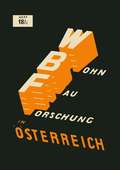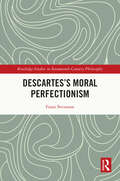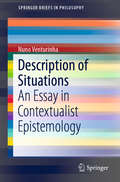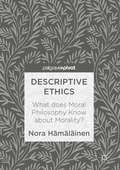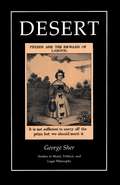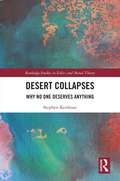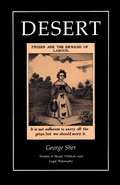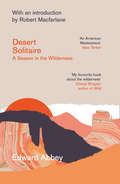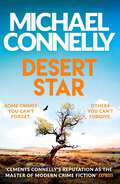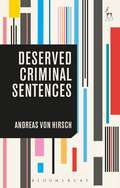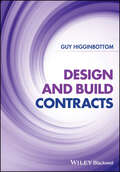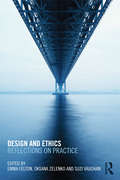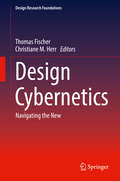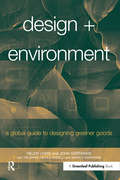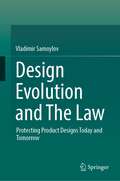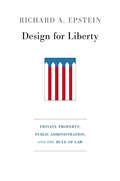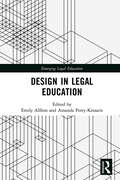- Table View
- List View
Derrida and Textual Animality: For a Zoogrammatology of Literature (Palgrave Studies in Animals and Literature)
by Rodolfo PiskorskiDerrida and Textual Animality: For a Zoogrammatology of Literature analyses what has come to be known, in the Humanities, as ‘the question of the animal’, in relation to literary texts. Rodolfo Piskorski intervenes in the current debate regarding the non-human and its representation in literature, resisting popular materialist methodological approaches in the field by revisiting and revitalising the post-structuralist thought of Derrida and the ‘linguistic turn’. The book focuses on Derrida’s early work in order to frame deconstructive approaches to literature as necessary for a theory and practice of literary criticism that addresses the question of the animal, arguing that texts are like animals, and animals are like texts. While Derrida’s late writings have been embraced by animal studies scholars due to its overt focus on animality, ethics, and the non-human, Piskorski demonstrates the additional value of these early Derridean texts for the field of literary animal studies by proposing detailed zoogrammatological readings of texts by Freud, Clarice Lispector, Ted Hughes, and Darren Aronofsky, while in dialogue with thinkers such as Butler, Kristeva, Genette, Deleuze and Guattari, and Attridge.
Derzeitige Bestimmungen und Ausführungen in Österreich einschließlich Schallschutz: (pdf) (Schriftenreihe der Forschungsgesellschaft für den Wohnungsbau im ÖIAV, Wien #18 / 2)
by Friedrich Bruckmayer Hans ThalerDescartes’s Moral Perfectionism (Routledge Studies in Seventeenth-Century Philosophy)
by Frans SvenssonThis book offers a novel and comprehensive interpretation of Descartes’s moral philosophy. In contrast to other influential interpretations, the book argues that the central tenet of his ethical thought is that each person ought to live in the way that is most conducive to their degree of overall perfection.While Descartes’s ethical thought has attracted only a very modest amount of attention among scholars, this book demonstrates that it constitutes an important and integral component of his philosophical project as a whole. It argues that Descartes’s ethics constitutes a form of moral perfectionism. In the Cartesian picture, we satisfy this requirement of perfection by using our free will well in all our conduct, something which is also necessary for obtaining happiness for ourselves. To be guaranteed happiness, however, we need to acquire the virtue of generosity, which, besides a habit of using one’s free will well, entails a habit of being attentive in one’s thought to various truths about oneself and about the world we live in. Descartes offers an interesting attempt to make living well depend entirely on ourselves and not on fate or fortune. He also leaves room for the presence of passions within such a life and for acknowledging that even fully virtuous persons’ lives may differ in their degrees of overall perfection.Descartes’s Moral Perfectionism will appeal to scholars and graduate students working on Descartes, the history of early modern philosophy, and the history of ethics.
Descartes’s Moral Perfectionism (Routledge Studies in Seventeenth-Century Philosophy)
by Frans SvenssonThis book offers a novel and comprehensive interpretation of Descartes’s moral philosophy. In contrast to other influential interpretations, the book argues that the central tenet of his ethical thought is that each person ought to live in the way that is most conducive to their degree of overall perfection.While Descartes’s ethical thought has attracted only a very modest amount of attention among scholars, this book demonstrates that it constitutes an important and integral component of his philosophical project as a whole. It argues that Descartes’s ethics constitutes a form of moral perfectionism. In the Cartesian picture, we satisfy this requirement of perfection by using our free will well in all our conduct, something which is also necessary for obtaining happiness for ourselves. To be guaranteed happiness, however, we need to acquire the virtue of generosity, which, besides a habit of using one’s free will well, entails a habit of being attentive in one’s thought to various truths about oneself and about the world we live in. Descartes offers an interesting attempt to make living well depend entirely on ourselves and not on fate or fortune. He also leaves room for the presence of passions within such a life and for acknowledging that even fully virtuous persons’ lives may differ in their degrees of overall perfection.Descartes’s Moral Perfectionism will appeal to scholars and graduate students working on Descartes, the history of early modern philosophy, and the history of ethics.
Description of Situations: An Essay in Contextualist Epistemology (SpringerBriefs in Philosophy)
by Nuno VenturinhaThis book approaches classic epistemological problems from a contextualist perspective. The author takes as his point of departure the fact that we are situated beings, more specifically that every single moment in our lives is already given within the framework of a specific context in the midst of which we understand ourselves and what surrounds us.In the process of his investigation, the author explores, in a fresh way, the works of key thinkers in epistemology. These include Bernard Bolzano, René Descartes, Gottlob Frege, Edmund Husserl, Immanuel Kant and Ludwig Wittgenstein, but also contemporary authors such as Stewart Cohen, Keith DeRose, David Lewis, Duncan Pritchard, Ernest Sosa and Charles Travis. Some of the topics covered are attributions of knowledge, the correspondence theory of truth, objectivity and subjectivity, possible worlds, primary and secondary evidence, scepticism, transcendentalism and relativism. The book also introduces a new contextualist thought-experiment for dealing with moral questions.Contextualism has received a great deal of attention in contemporary epistemology. It has the potential to resolve a number of issues that traditional epistemological approaches cannot address. In particular, a contextualist view opens the way to an understanding of those cognitive processes that require situational information to be fully grasped. However, contextualism poses serious difficulties in regard to epistemic invariance. This book offers readers an innovative approach to some fundamental questions in this field.
Descriptive Ethics: What does Moral Philosophy Know about Morality?
by Nora HämäläinenThis book is an investigation into the descriptive task of moral philosophy. Nora Hämäläinen explores the challenge of providing rich and accurate pictures of the moral conditions, values, virtues, and norms under which people live and have lived, along with relevant knowledge about the human animal and human nature. While modern moral philosophy has focused its energies on normative and metaethical theory, the task of describing, uncovering, and inquiring into moral frameworks and moral practices has mainly been left to social scientists and historians. Nora Hämäläinen argues that this division of labour has detrimental consequences for moral philosophy and that a reorientation toward descriptive work is needed in moral philosophy. She traces resources for a descriptive philosophical ethics in the work of four prominent philosophers of the twentieth century: John Dewey, Ludwig Wittgenstein, Michel Foucault, and Charles Taylor, while also calling on thinkers inspired by them.
Desert (Studies in Moral, Political, and Legal Philosophy #3)
by George SherThe description for this book, Desert, will be forthcoming.
Desert Collapses: Why No One Deserves Anything (Routledge Studies in Ethics and Moral Theory)
by Stephen KershnarPeople consider desert part of our moral world. It structures how we think about important areas such as love, punishment, and work. This book argues that no one deserves anything. If this is correct, then claims that people deserve general and specific things are false. At the heart of desert is the notion of moral credit or discredit. People deserve good things (credit) when they are good people or do desirable things. These desirable things might be right, good, or virtuous acts. People deserve bad things (discredit) when they are bad people or do undesirable things. On some theories, people deserve credit in general terms. For instance, they deserve a good life. On other theories, people deserve credit in specific terms. For instance, they deserve specific incomes, jobs, punishments, relationships, or reputations. The author’s argument against desert rests on three claims: There is no adequate theory of what desert is. Even if there were an adequate theory of what desert is, nothing grounds (justifies) desert. Even if there were an adequate theory of what desert is and something were to ground it, there is no plausible account of what people deserve. Desert Collapses will be of interest to researchers and advanced students working in ethics and political philosophy.
Desert Collapses: Why No One Deserves Anything (Routledge Studies in Ethics and Moral Theory)
by Stephen KershnarPeople consider desert part of our moral world. It structures how we think about important areas such as love, punishment, and work. This book argues that no one deserves anything. If this is correct, then claims that people deserve general and specific things are false. At the heart of desert is the notion of moral credit or discredit. People deserve good things (credit) when they are good people or do desirable things. These desirable things might be right, good, or virtuous acts. People deserve bad things (discredit) when they are bad people or do undesirable things. On some theories, people deserve credit in general terms. For instance, they deserve a good life. On other theories, people deserve credit in specific terms. For instance, they deserve specific incomes, jobs, punishments, relationships, or reputations. The author’s argument against desert rests on three claims: There is no adequate theory of what desert is. Even if there were an adequate theory of what desert is, nothing grounds (justifies) desert. Even if there were an adequate theory of what desert is and something were to ground it, there is no plausible account of what people deserve. Desert Collapses will be of interest to researchers and advanced students working in ethics and political philosophy.
Desert Solitaire: A Season In The Wilderness
by Edward Abbey‘My favourite book about the wilderness’ Cheryl Strayed, author of Wild In this shimmering masterpiece of American nature writing, Edward Abbey ventures alone into the canyonlands of Moab, Utah, to work as a seasonal ranger for the United States National Park Service.
Desert Star: The Brand New Blockbuster Ballard & Bosch Thriller
by Michael ConnellyTHE WORLDWIDE #1 BESTSELLER BEHIND AMAZON PRIME'S BOSCH AND NETFLIX'S THE LINCOLN LAWYERSOME CRIMES YOU CAN'T FORGET.Detective Renée Ballard is given the chance of a lifetime: revive the LAPD's cold case unit and find justice for the families of the forgotten. The only catch is they must first crack the unsolved murder of the sister of the city councilman who is sponsoring the department - or lose everything...OTHERS YOU CAN'T FORGIVE.Harry Bosch is top of the list of investigators Ballard wants to recruit. The former homicide detective is a living legend - but for how long? Because Bosch has his own agenda: a crime that has haunted him for years - the murder of a whole family, buried out in the desert - which he vowed to close.WHAT WOULD YOU DO IF YOU KNEW WHO DID IT?With the killer still out there and evidence elusive - Bosch is on a collision course with a choice he hoped never to make...* * * * *CRIME DOESN'T COME BETTER THAN CONNELLY:'The pre-eminent detective novelist of his generation'IAN RANKIN'The best mystery writer in the world'GQ'One of the greatest crime writers'DAILY MAIL'A superb natural storyteller'LEE CHILD'A master'STEPHEN KING'A genius'INDEPENDENT ON SUNDAY'Crime thriller writing of the highest order'GUARDIAN'A terrific writer with pace, style and humanity to spare'THE TIMES'America's greatest living crime writer'DAILY EXPRESS'One of the great storytellers of crime fiction'SUNDAY TELEGRAPH
Deserved Criminal Sentences
by Andreas Von HirschThis book provides an accessible and systematic restatement of the desert model for criminal sentencing by one of its leading academic exponents. The desert model emphasises the degree of seriousness of the offender's crime in deciding the severity of his punishment, and has become increasingly influential in recent penal practice and scholarly debate. It explains why sentences should be based principally on crime-seriousness, and addresses, among other topics, how a desert-based penalty scheme can be constructed; how to gauge punishments' seriousness and penalties' severity; what weight should be given to an offender's previous convictions; how non-custodial sentences should be scaled; and what leeway there might be for taking other factors into account, such as an offender's need for treatment. The volume will be of interest to all those working in penal theory and practice, criminal sentencing and the criminal law more generally.
Deserved Criminal Sentences
by Andreas Von HirschThis book provides an accessible and systematic restatement of the desert model for criminal sentencing by one of its leading academic exponents. The desert model emphasises the degree of seriousness of the offender's crime in deciding the severity of his punishment, and has become increasingly influential in recent penal practice and scholarly debate. It explains why sentences should be based principally on crime-seriousness, and addresses, among other topics, how a desert-based penalty scheme can be constructed; how to gauge punishments' seriousness and penalties' severity; what weight should be given to an offender's previous convictions; how non-custodial sentences should be scaled; and what leeway there might be for taking other factors into account, such as an offender's need for treatment. The volume will be of interest to all those working in penal theory and practice, criminal sentencing and the criminal law more generally.
Design and Build Contracts
by Guy HigginbottomDESIGN AND BUILD CONTRACTS Design and build (D&B) construction procurement relies on a project’s main contractor shouldering the responsibility for creating the design and executing the construction for a project. While the extent of contractor-produced design can vary, this method of construction procurement affords the contractor a greater level of input and responsibility than traditionally procured contracts (where the employer has greater design responsibility). Over the last decade in the UK, it has become clear that D&B contracts are becoming the most popular method for procuring construction projects; often echoing the ways in which contracts for infrastructure and process plant can be procured. Whilst D&B can provide a greater degree of contractor input for producing feasibility and concept designs, then the detailed design to deliver a project, many clients amend standard forms of D&B contracts to alter the contractors’ design input. This can significantly change D&B, deviating from the procedures set out in the standard forms of D&B contract. This book firstly takes the reader through each stage of a project (based upon the RIBA Plan of Work 2020) to provide guidance on how D&B contracts were intended to operate, then secondly, identifying how D&B contracts and their procedures have changed. Readers will find: Outline commentary and guidance on commonly used standard forms of D&B contract, including: JCT Design and Build 2016; FIDIC Conditions of Contract for Plant Design-Build 2017; and NEC4 How each D&B contract is intended to operate during each stage of the RIBA Plan of Work 2020 How the operation of D&B contracts and their procedures are often amended. An ideal resource for contractors, employers, and consultants, as well as those studying construction at university, Design and Build Contracts offers helpful commentary and guidance for how each stage of a D&B engineering or construction project should progress.
Design and Build Contracts
by Guy HigginbottomDESIGN AND BUILD CONTRACTS Design and build (D&B) construction procurement relies on a project’s main contractor shouldering the responsibility for creating the design and executing the construction for a project. While the extent of contractor-produced design can vary, this method of construction procurement affords the contractor a greater level of input and responsibility than traditionally procured contracts (where the employer has greater design responsibility). Over the last decade in the UK, it has become clear that D&B contracts are becoming the most popular method for procuring construction projects; often echoing the ways in which contracts for infrastructure and process plant can be procured. Whilst D&B can provide a greater degree of contractor input for producing feasibility and concept designs, then the detailed design to deliver a project, many clients amend standard forms of D&B contracts to alter the contractors’ design input. This can significantly change D&B, deviating from the procedures set out in the standard forms of D&B contract. This book firstly takes the reader through each stage of a project (based upon the RIBA Plan of Work 2020) to provide guidance on how D&B contracts were intended to operate, then secondly, identifying how D&B contracts and their procedures have changed. Readers will find: Outline commentary and guidance on commonly used standard forms of D&B contract, including: JCT Design and Build 2016; FIDIC Conditions of Contract for Plant Design-Build 2017; and NEC4 How each D&B contract is intended to operate during each stage of the RIBA Plan of Work 2020 How the operation of D&B contracts and their procedures are often amended. An ideal resource for contractors, employers, and consultants, as well as those studying construction at university, Design and Build Contracts offers helpful commentary and guidance for how each stage of a D&B engineering or construction project should progress.
Design and Ethics: Reflections on Practice
by Emma Felton Oksana Zelenko Suzi VaughanThe value of design for contributing to environmental solutions and a sustainable future is increasingly recognised. It spans many spheres of everyday life, and the ethical dimension of design practice that considers environmental, social and economic sustainability is compelling. Approaches to design recognise design as a practice that can transform human experience and understanding, expanding its role beyond stylistic enhancement. The traditional roles of design, designer and designed object are therefore redefined through new understanding of the relationship between the material and immaterial aspects of design where the design product and the design process are embodiments of ideas, values and beliefs. This multi-disciplinary approach considers how to create design which is at once aesthetically pleasing and also ethically considered, with contributions from fields as diverse as architecture, fashion, urban design and philosophy. The authors also address how to teach design based subjects while instilling a desire in the student to develop ethical work practices, both inside and outside the studio.
Design and Ethics: Reflections on Practice
by Emma Felton Oksana Zelenko Suzi VaughanThe value of design for contributing to environmental solutions and a sustainable future is increasingly recognised. It spans many spheres of everyday life, and the ethical dimension of design practice that considers environmental, social and economic sustainability is compelling. Approaches to design recognise design as a practice that can transform human experience and understanding, expanding its role beyond stylistic enhancement. The traditional roles of design, designer and designed object are therefore redefined through new understanding of the relationship between the material and immaterial aspects of design where the design product and the design process are embodiments of ideas, values and beliefs. This multi-disciplinary approach considers how to create design which is at once aesthetically pleasing and also ethically considered, with contributions from fields as diverse as architecture, fashion, urban design and philosophy. The authors also address how to teach design based subjects while instilling a desire in the student to develop ethical work practices, both inside and outside the studio.
Design Cybernetics: Navigating the New (Design Research Foundations)
by Thomas Fischer Christiane M. HerrDesign Cybernetics: Navigating the New Design cybernetics offers a way of looking at ourselves – curious, creative, and ethical humans – as self-organising systems that negotiate their own goals in open-ended explorations of the previously unknown. It is a theory of and for epistemic practices (learning, designing, researching) that is deeply committed to the autonomy of others and hence offers no prescriptive methodology. Design cybernetics describes design practice as inextricable from conversation – a way of enquiring, developing shared understanding and reaching the new that harnesses reliable control as well as error and serendipity. Recognising circular causality, observer-dependency and non-determinability, design cybernetics extends beyond tenets of scientific research into the creative, ethical and aesthetic domain. From this perspective, design is not an ill-conceived subset of scientific research. Instead, scientific research emerges as a particularly restricted subset of the broader human activity of design. This volume offers a cross-section of design cybernetic theory and practice with contributions ranging across architecture, interior lighting studies, product design, embedded systems, design pedagogy, design theory, social transformation design, research epistemology, art and poetics, as well as theatre and acting. Addressing designers, design educators and researchers interested in a rigorous, practice-based epistemology, it establishes design cybernetics as a foundational perspective of design research. “This is a conceptually elegant, well structured, and comprehensive presentation of design cybernetics. It fills a gap in the literature of the field.” Ken Friedman, Chair Professor, Tongji University “This book offers a valuable and timely introduction to second-order cybernetics as society grapples with complex issues like climate change and rising inequality.” Joichi Ito, Director of the MIT Media Lab
Design + Environment: A Global Guide to Designing Greener Goods
by Helen Lewis John Gertsakis Tim Grant Nicola Morelli Andrew SweatmanThere is a huge scarcity of good, practical resources for designers and students interested in minimizing the environmental impacts of products. Design + Environment has been specifically written to address this paucity. The book first provides background information to help the reader understand how and why design for environment (DfE) has become so critical to design, with reference to some of the most influential writers, designers and companies in the field. Next, Design + Environment provides a step-by-step approach on how to approach DfE: to design a product that meets requirements for quality, cost, manufacturability and consumer appeal, while at the same time minimising environmental impacts. The first step in the process is to undertake an assessment of environmental impacts, using life-cycle assessment (LCA) or one of the many simpler tools available to help the designer. From then on, DfE becomes an integral part of the normal design process, including the development of concepts, design of prototypes, final design and development of marketing strategies. Environmental assessment tools and strategies to reduce environmental impacts, such as the selection of appropriate materials, are then discussed. Next, some of the links between environmental problems, such as global warming, ozone depletion, water and air pollution and the everyday products we consume are considered. In order to design products with minimal environmental impact, we need to have a basic understanding of these impacts and the interactions between them. The four subsequent chapters provide more detailed strategies and case studies for particular product groups: packaging, textiles, furniture, and electrical and electronic products. Guidelines are provided for each of the critical stages of a product's life, from the selection of raw materials through to strategies for recovery and recycling. Finally, Design + Environment takes a look at some of the emerging trends in DfE that are offering us the opportunity to make a more significant reduction in environmental impacts. Both the development of more sustainable materials and technologies and the growing interest in leasing rather than selling products are examined. Design + Environment is organized as a workbook rather than an academic text. It should be read once, and then used as a key reference source. This clear and informative book will prove to be invaluable to practising designers, to course directors and their students in need of a core teaching and reference text and to all those interested in learning about the tools and trends influencing green product design. The authors have all been involved in an innovative demonstration programme called "EcoReDesign", which was developed by the Centre for Design at RMIT University with funding from the Australian government. The Centre successfully collaborated with Australian companies to improve the environmental performance of their products by following DfE principles.
Design + Environment: A Global Guide to Designing Greener Goods
by Helen Lewis John Gertsakis Tim Grant Nicola Morelli Andrew SweatmanThere is a huge scarcity of good, practical resources for designers and students interested in minimizing the environmental impacts of products. Design + Environment has been specifically written to address this paucity. The book first provides background information to help the reader understand how and why design for environment (DfE) has become so critical to design, with reference to some of the most influential writers, designers and companies in the field. Next, Design + Environment provides a step-by-step approach on how to approach DfE: to design a product that meets requirements for quality, cost, manufacturability and consumer appeal, while at the same time minimising environmental impacts. The first step in the process is to undertake an assessment of environmental impacts, using life-cycle assessment (LCA) or one of the many simpler tools available to help the designer. From then on, DfE becomes an integral part of the normal design process, including the development of concepts, design of prototypes, final design and development of marketing strategies. Environmental assessment tools and strategies to reduce environmental impacts, such as the selection of appropriate materials, are then discussed. Next, some of the links between environmental problems, such as global warming, ozone depletion, water and air pollution and the everyday products we consume are considered. In order to design products with minimal environmental impact, we need to have a basic understanding of these impacts and the interactions between them. The four subsequent chapters provide more detailed strategies and case studies for particular product groups: packaging, textiles, furniture, and electrical and electronic products. Guidelines are provided for each of the critical stages of a product's life, from the selection of raw materials through to strategies for recovery and recycling. Finally, Design + Environment takes a look at some of the emerging trends in DfE that are offering us the opportunity to make a more significant reduction in environmental impacts. Both the development of more sustainable materials and technologies and the growing interest in leasing rather than selling products are examined. Design + Environment is organized as a workbook rather than an academic text. It should be read once, and then used as a key reference source. This clear and informative book will prove to be invaluable to practising designers, to course directors and their students in need of a core teaching and reference text and to all those interested in learning about the tools and trends influencing green product design. The authors have all been involved in an innovative demonstration programme called "EcoReDesign", which was developed by the Centre for Design at RMIT University with funding from the Australian government. The Centre successfully collaborated with Australian companies to improve the environmental performance of their products by following DfE principles.
Design Evolution and The Law: Protecting Product Designs Today and Tomorrow
by Vladimir SamoylovThis book focuses on product design which is evolving conceptually and practically with advances in technology. Product design is no longer solely about product stylization and decoration, but rather about providing a holistic product experience for the consumer. Therefore, in the foreseeable future, product designs will increasingly communicate not only to our eyes, but to our other senses as well.This book examines the frameworks for the protection of product designs in New Zealand and Australia and evaluates the appropriateness of expanding legal mechanisms for the accommodation of product design evolution. The value of more holistic design protection is balanced against other important considerations such as the “right to repair".The book not only anticipates the extent to which product design will cater to senses other than visual, but also provides a novel framework (with reference to industry examples) for discerning originality in such work for the purposes of copyright. This book also makes suggestions for how designs can be protected from foreseeable infringement (analogous to copyright infringement of music and movies on file sharing networks) resulting from future advances in technologies such as 3D printing and virtual reality.
Design for Liberty: Private Property, Public Administration, and the Rule of Law
by Richard A. EpsteinFollowing a vast expansion in the twentieth century, government is beginning to creak at the joints under its enormous weight. The signs are clear: a bloated civil service, low approval ratings for Congress and the President, increasing federal-state conflict, rampant distrust of politicians and government officials, record state deficits, and major unrest among public employees. In this compact, clearly written book, the noted legal scholar Richard Epstein advocates a much smaller federal government, arguing that our over-regulated state allows too much discretion on the part of regulators, which results in arbitrary, unfair decisions, rent-seeking, and other abuses. Epstein bases his classical liberalism on the twin pillars of the rule of law and of private contracts and property rights—an overarching structure that allows private property to keep its form regardless of changes in population, tastes, technology, and wealth. This structure also makes possible a restrained public administration to implement limited objectives. Government continues to play a key role as night-watchman, but with the added flexibility in revenues and expenditures to attend to national defense and infrastructure formation. Although no legal system can eliminate the need for discretion in the management of both private and public affairs, predictable laws can cabin the zone of discretion and permit arbitrary decisions to be challenged. Joining a set of strong property rights with sound but limited public administration could strengthen the rule of law, with its virtues of neutrality, generality, clarity, consistency, and forward-lookingness, and reverse the contempt and cynicism that have overcome us.
Design in Legal Education (Emerging Legal Education)
by Emily AllbonThis visually rich, experience-led collection explores what design can do for legal education. In recent decades design has increasingly come to be understood as a resource to improve other fields of public, private and civil society practice; and legal design—that is, the application of design-based methods to legal practice—is increasingly embedded in lawyering across the world. It brings together experts from multiple disciplines, professions and jurisdictions to reflect upon how designerly mindsets, processes and strategies can enhance teaching and learning across higher education, public legal information and legal practice; and will be of interest and use to those teaching and learning in any and all of those fields.
Design in Legal Education (Emerging Legal Education)
by Emily Allbon Amanda Perry-KessarisThis visually rich, experience-led collection explores what design can do for legal education. In recent decades design has increasingly come to be understood as a resource to improve other fields of public, private and civil society practice; and legal design—that is, the application of design-based methods to legal practice—is increasingly embedded in lawyering across the world. It brings together experts from multiple disciplines, professions and jurisdictions to reflect upon how designerly mindsets, processes and strategies can enhance teaching and learning across higher education, public legal information and legal practice; and will be of interest and use to those teaching and learning in any and all of those fields.

